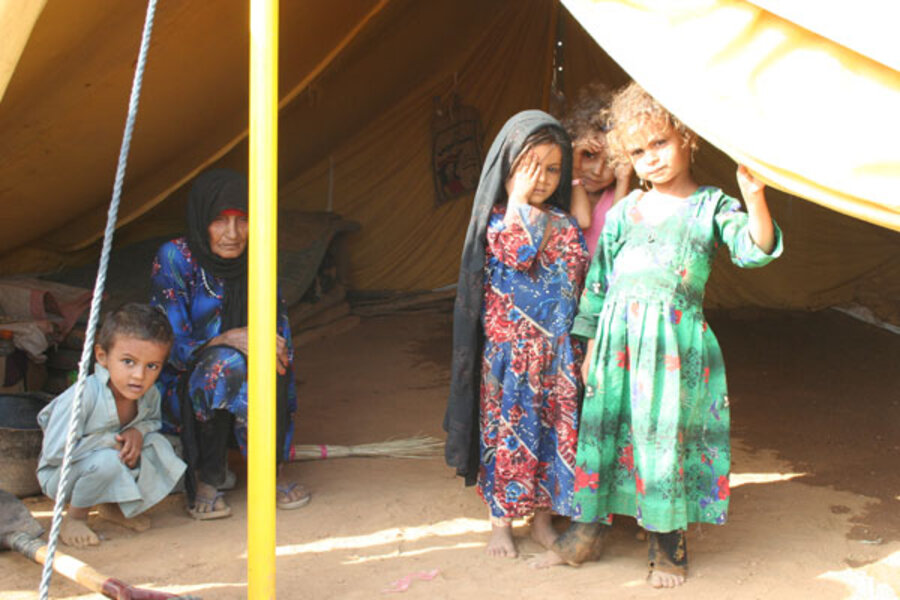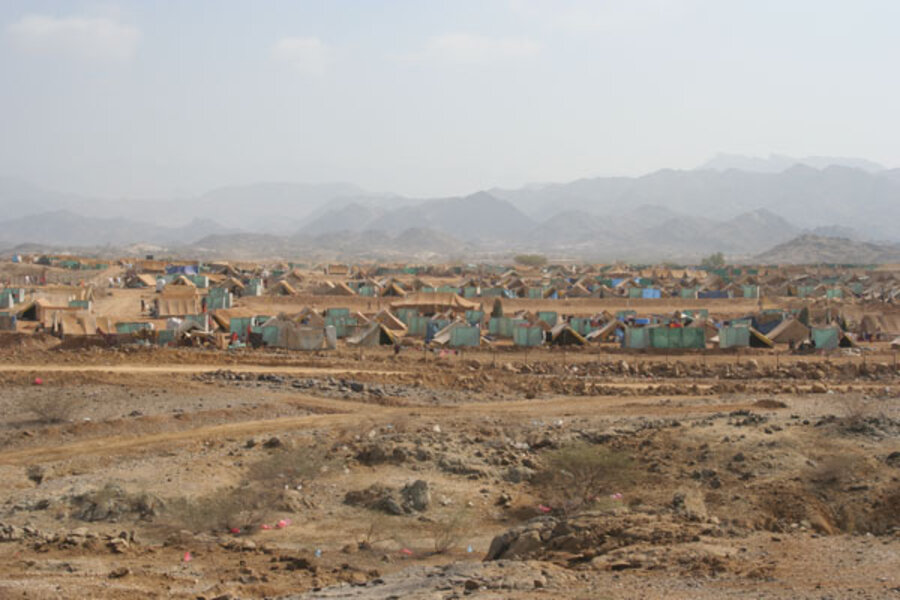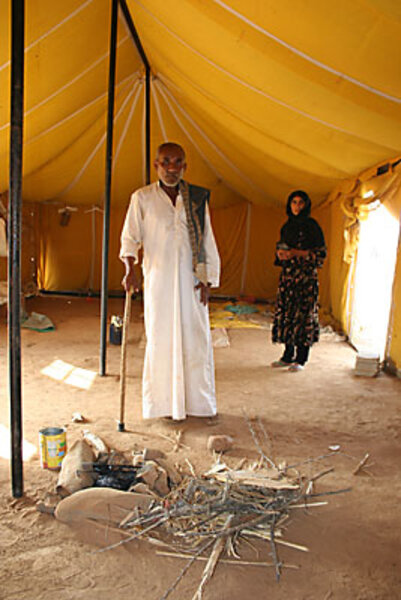Fresh fighting in Yemen ignites refugee crisis
Loading...
| Mazrak, Yemen
As the fighting between Yemeni forces and Houthi rebels escalates in the country’s remote northern region, the international community has focused largely on the potential for the war to further weaken the central government – leaving it vulnerable to threats from both separatists and militant Islamists.
But largely unseen by the outside world, the humanitarian consequences are mounting in refugee camps rarely accessed by Western journalists. Displaced families – some with their goats, sheep, donkeys, and cows in tow – are steadily filing into the UNHCR-run camps in Mazrak, forcing the agency to open a third one at the end of last week.
With the dull thud of artillery fire in the distance, Hussein Abdullah describes how his family was forced to first flee their village into nearby Saudi Arabia and was then forced to leave Saudi Arabia after the Houthis attacked a Saudi border post.
“After the Saudis started fighting the Houthis,” he says, “they told us we could not stay in Saudi Arabia. We left with nothing more than we could carry. My cattle are still in Saudi Arabia. How am I supposed to get them back?”
Hussein is one of the many Yemenis who first fled to Saudi Arabia and were then forced to return to Yemen, eventually making their way to the UNHCR-run Internal Displaced Person (IDP) camps at Mazrak.
According to the UNHCR office in the nearby town of Harad, the population of the largest of the three camps has doubled in the last month to 16,675. However, this number is only a fraction of the estimated 150,000 who have been forced to flee the on-again, off-again fighting that has plagued the north for five years.
“My house was bombed and, by God, I don’t even know who bombed it. We lost everything,” says Fatima Ghais, as she stood in a tent and pointed to a plastic bag that held some clothes and plastic cups. Ghais, like many in the camp, is completely dependent on the UNHCR and other relief services which are providing food, water, and shelter.
The day before the third camp opened on Dec. 17, another 64 families arrived, estimated Nabil Ahmad, an assistant manager with Islamic Relief. Outside the camps, dozens of civilians have reportedly been wounded and killed in the northern Saada governorate, according to an update published today by the International Committee of the Red Cross.
High praise for UNHCR
In the town of Mazrak, Yemeni soldiers crowd the town’s qat market – the mild narcotic leaf is a key staple of society here – before heading back to the front, only 19 miles away in Minzalah. Despite five years of fighting, Yemen’s army has been unable to quell the Houthi rebellion, which has escalated in recent months due to a renewed offensive by the Yemeni army.
The Yemeni government claims that the Houthis – adherents to a radical form of Zaidism, a conservative off-shoot of Shiite Islam – want to overthrow Yemen’s government and reestablish the imamate. However, the Houthis, who have never clearly articulated their political agenda, deny this and say they are fighting to defend their land, beliefs, and culture against a government that discriminates against them.
In November, the conflict took on a regional dimension when Saudi Arabia, responding to attacks by Houthi rebels, began what Saudi officials describe as a border security operation. The Saudis are attempting to create a cordon sanitaire seven miles deep along part of their border. The fallout from this operation has been an escalation in fighting and a surge in displaced persons.
In the already stifling mid-morning heat, people crowd around, anxious to tell their stories.
“I didn’t even know the name Mazrak and now I am here. God knows when I will leave,” says Dhaifah Jarah, who describes how her entire village was destroyed by jets dropping bombs. “I don’t know who did it. Some of the men said they were Saudi planes but only God knows who it was.”
Jarah, whose husband is dead, lives by herself in one of the tents. Her only possessions are a mattress and the clothes she is wearing.
A man from the town of Bini Sad, who gives his name only as Abdul Kareem, says he was also bombed out of his home.
“First the Houthis stole my sheep and then all this bombing started. When will it end?” he asks, as the heavy rattle of machine gun fire sounds off again in the distance. Most of the people gathered around had high praise for the efforts of the UNHCR and other relief services.
“Yes, we have food, thank God,” says Mohammed Ali, another resident of the camp. “There are some problems but we are surviving.”
Malnourished children and 14,000 head of livestock
The UNHCR and other agencies working in the camps face a daunting task. In addition to providing shelter, food, and water for thousands of people in a hot and largely arid region, the agencies must also cope with an estimated 14,000 head of livestock that people have brought with them. The French NGO Triangle provides food and vaccinations for the assortment of goats, sheep, donkeys, and cows.
“They are bringing us food for our animals,” says Jibran Ali, as he points to some goats chewing on dried maize stalks. Mr. Ali is one of the fortunate few: He was able to flee with his animals. Most of the residents of the camps had to leave their livestock behind, some with neighbors, while others were forced to abandon their animals in Saudi Arabia after they were deported. “How will the people recover from this – all these animals lost here and there? These animals are our wealth. They are all we have.”
In front of one of the camp’s water tanks, a malnourished boy named Mohammed stands in the mud with his older sister. According to UNICEF, the agency and its partner Medecins Sans Frontieres are dealing with more than 600 severely malnourished children. Adnan Abdul Fattah, director of the UNICEF program in Mazrak, said that in addition to those cases, UNICEF must also cope with widespread moderate malnourishment among children in the camps. An estimated 45 percent of children in Yemen suffer from malnutrition.
UN appeals for $177 million in aid
With no sign that the war will end soon, the UNHCR is proceeding with its long-term plan to bring water and electricity to the camps. The UN recently launched a $177 million appeal for aid to help fund its Yemen Humanitarian Response Plan.
Both the Yemeni and Saudi governments say that they are defeating the Houthi rebels. However, the Yemeni government has repeatedly claimed victories against the Houthis in the past, only to have the fighting flare up again. Sheltered in her tent from the hot afternoon sun, Jarah wonders, “Will I ever see my home again? Look at me. I am an old woman. How long will I be here?”







